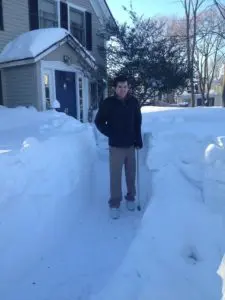by Maxwell T. Goldman
Access Planner
The first time I used my scooter in the snow was an experience I’ll never forget. I was a sophomore in college, heading back to my dorm after class when suddenly, what started out as little fluffy flakes, quickly became white-out conditions. As I turned up my dial to accelerate, I realized that no matter how fast I was going, my little scooter would be no match for the slushy 1.5-mile trek ahead of me. I was halfway up the hill leading to my dorm when my scooter got stuck. As the wheels spun in place, I remember thinking “why don’t I live somewhere warm?” Luckily, as I pulled out my cellphone to call public safety, two generous strangers walking by gave me a push, and within minutes I was safe and warm inside. Although the experience was frightening, it’s nothing compared to what other people with mobility challenges face in cold weather situations. For some, being stuck can be the difference between life and death.
Since that experience, I make sure to plan ahead during inclement weather, and so far, I’ve been lucky not to repeat it. Although I have the privilege to control certain variables, like bribing my little brother to shovel out my car, or having my dad carry me across our icy driveway, many people with mobility challenges rely on variables outside their control to stay safe. When sidewalks are not plowed, or when snowbanks create impenetrable barriers at curb cuts, living independently can be a challenge.

In the city of Boston, property owners are required to clear a 42-inch-wide path (or the full width of the sidewalk) within three hours after a snowstorm ends (“Rules on Clearing Snow”). If Massachusetts property owners are unsure about their obligations, they can view a “Sidewalk Snow Removal Map” which indicates whose responsibility it is to clear the sidewalks within each community. Additionally, Boston residents can use the Bos: 311 app or call the mayor’s hotline at 617-635-4500 to report sidewalks that haven’t been cleared.
Although communities in the snow belt will eventually remove all the snow from city streets, including sidewalks and curb cuts, people with mobility difficulties often need help in the critical window between when the first flakes fall, to when the dust finally settles. Unfortunately for people living in Boston, there are limited resources to get help during this window. The consensus is that people in need of snow removal should reach out to neighbors and volunteer programs. In Boston, for the 2017-2018 winter season, I was only able to find one snow removal program, the “Snow Angels,” which will remove snow on demand for the elderly and disabled in South Boston.
Hopefully, with more awareness about snow removal and more volunteer programs to help the mobility challenged, people and communities will take it upon themselves to help each other and create a safer place.
Sources:
“Rules on Clearing Snow.” Boston.gov, 4 Dec. 2017, https://www.boston.gov/departments/311/rules-clearing-snow.


